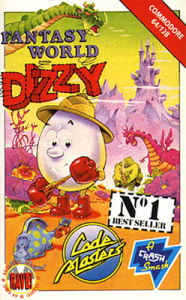945th played so far
Genre: Action/Adventure
Platform: Various
Year of Release: 1989
Developer: Oliver Twins
Publisher: Codemasters
Both because of my interest in older games and to prep playing older games, I regularly read the Retro Gamer magazine for a while. I haven’t taken the time to do so in a while, but one of the series I remember reading about a lot is the Dizzy series. It came up often, possibly in part because the Oliver twins were often up for interviews and because there was a lot of love for it (as well as an upcoming at the time Kickstarter campaign), but it seemed I had to play it for myself to really get it. There’s only one game in the series on the list, and this is the one. I hope this will let me see why it’s so beloved.
Our Thoughts
It feels like the action/adventure has drifted, at some point, into its own genre rather than a combination of the two as we (internally) treat these genre combinations on the blog. While Tomb Raider originally had some vague exploration and puzzle elements, it’s hard to see how Grand Theft Auto IV or Uncharted still have adventure game elements. Rather, they are action games that take place in levels that aren’t entirely linear and may reward some exploration, or are games that take place in an open world with a story structure. The adventure element here is how you vaguely interact with the world, as well as a link to the genre in other media.
Fantasy World Dizzy shows how these (often arbitrary) boundaries made more sense thirty years ago. There is an action element to the game in its platforming and timing (jumping a crocodile at the right time so you can keep his jaws wedged open), while a lot of it revolves around basic adventure elements – finding elements and using them in the right place to progress the story or the characters. It’s no Monkey Island, but the core of moving items and combining them is there, with some sideways logic and experimentation as you try to connect the dots. I suspect that similar flowcharts underlie both games.
If the game allowed it, I would have loved exploring that – walking around the area, trying to figure out what goes where, and exploring the world as you do. It doesn’t look fancy, sure, but there’s enough going on here that it’s a neat place to go through.
Unfortunately, the action elements trips it up. First, as you almost had to have in the eighties, you only have limited lives. You have your jumping puzzles and action set pieces, but they are weirdly frustrating. The platforming is just fine, but it’s all that bit too lethal – torches hanging on the wall aren’t just decoration, jumping at the wrong point in a hallway can kill you. It’s an odd decision, as normally you don’t get hurt by background elements that way, and they don’t otherwise add to the challenge, it’s just another silly thing to remember. You lose your lives too quickly for them, forcing you to restart, which deters you from wanting to solve the later puzzles – it takes so long to reach them, and you have to hope you’ll have enough lives when you do, that you can’t have the safe experimentation you need in a game like this to work. Again, thirty years of progress, but I’d have loved a version hacked to give you unlimited lives so you can try things without being sent back to the start of the game every time.
Final Thoughts
The game’s deadliness is really frustrating, as it really hampers your ability to come to grips with what’s going on and feel you’re making progress. It doesn’t need it, because there’s a lot there in this game, and there seems to be enough in here that just resetting you to the screen each time would keep you going long enough.
